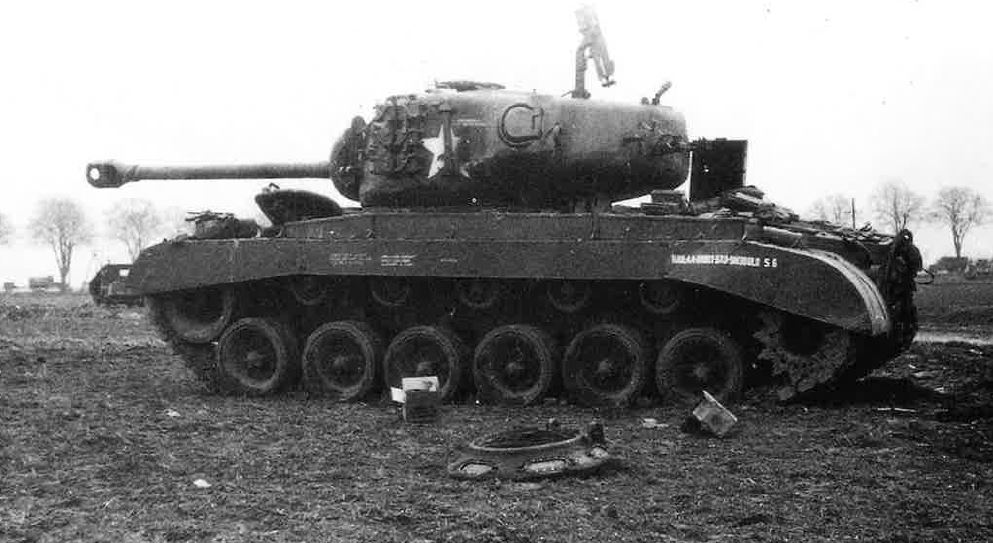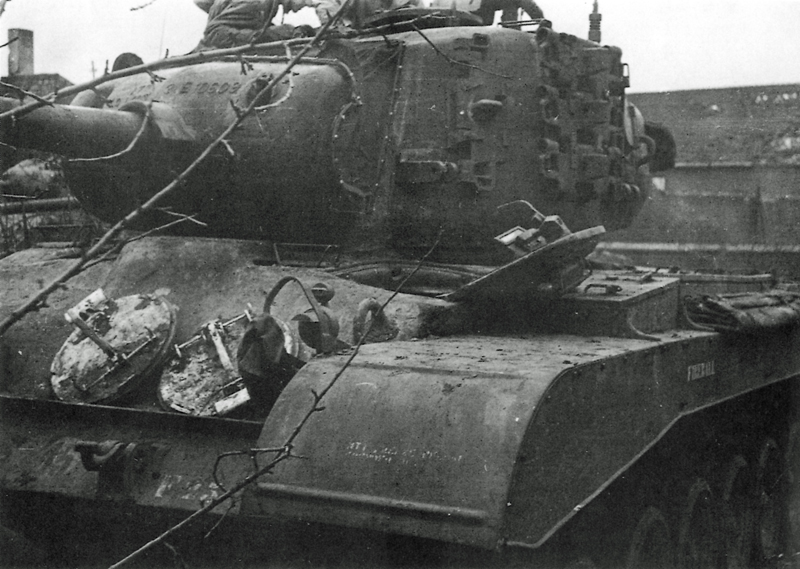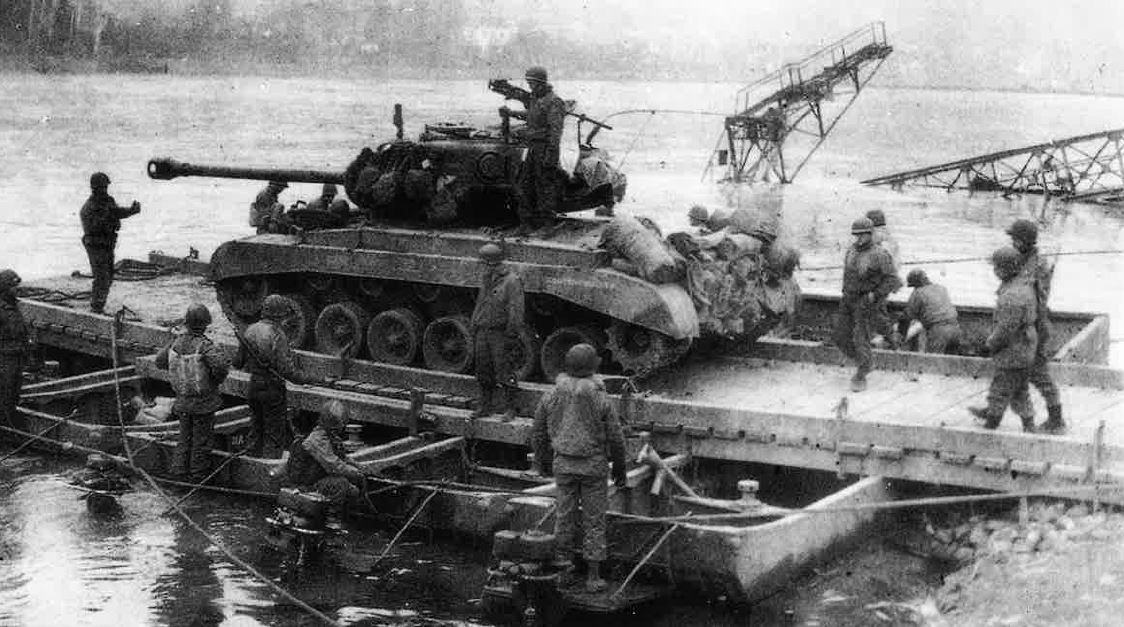
I will finish the current series on the timelines of the production and fielding of T26 General Pershing with Ordnance's view of the background to the Zebra Mission, the in-theatre combat testing of the tank. Then, my ponitification, which of course, is totally correct and beyond reproach. The below is transcribed straight from Ordnance's historical record.
While the difficulties surrounding the size of the gun on the heavy tank were in the process of settlement, another controversy arose. In March 1944 Ordnance proposed sending a T26 tank (along with five each of the T23 and T25 models) to the North African theater "in order to get a battle evaluation of these tanks since it was the Ordnance opinion that they would be an important factor on the battlefield if used to augment the fire power of the M4 tanks". Army Ground Forces answered bluntly that "the suggestion that a team of officers and experts and eleven experimental tanks be sent to NATOUSA is not favorably considered at this time." Ground Force headquarters added that "these tanks have not been tested by a service board, and it is not known whether they are fightable -and fit to be put in combat. This headquarters does not view with favor the idea of making any combat zone a testing agency." In view of the AGF attitude, Ordnance suggested that the Armored Board be sent to Aberdeen Proving Ground to witness tests of the T25 and T26 tanks. By expediting the tests, Ordnance felt, it might still be possible to send the vehicles to North Africa not later than the previously proposed date of 1 April 1944.

The problem with testing in a combat zone is that if the enemy knocks out your tank, you can't use it for testing any more. This was Pershing #22.
This new Ordnance proposal was apparently rejected by AGF, because ASF replied to the Ordnance indorsement with a statement that Commanding General, Army Ground Forces, had indicated that he would do everything possible to hasten the test of the heavy tanks and that a report might be forthcoming in about a month. Ordnance was instructed to ship T26 tanks to the home base of the Armored Board -- Fort Knox, Kentucky. Ordnance was also warned that pending clearance by AGF, none of these vehicles would be shipped to overseas theaters. Ordnance, of course, was required to abide by the decision of higher authority, but, for purposes of record, answered that "it is still the opinion of this office that the… T26 Tanks should be sent to the theaters where they may be required. It will take a considerable time to ship the tanks and to get them into service. The information which would be obtained would be of great value, both to the using service and to the Ordnance Department." Ordnance recommended that the decision to hold the shipment of these tanks pending service tests be reconsidered. The ASF decision was not changed.
In August of 1944,Ordnance again asked permission for combat test of the T26 tank and received approval from the General Staff for the formation of a tank platoon in the North African theater for the special purpose of testing these tanks in battle. Army Ground Forces, as it had before, strenuously resisted this proposed action, and was again able to obtain cancellation of overseas tests.
During the same month, the Ordnance Department also proposed the standardization of the T26 (actually the modification designated T26E1), but Army Ground Forces refused to concur on the grounds that service tests had not been completed, that tanks embodying improvements suggested by the Armored Board had not been provided for further test, that other modifications might prove necessary, that immediate standardization would not facilitate-either the development or production of the heavy tank. AGF wanted standardization withheld until the T26 had been proven battle-worthy.
Despite continued AGF opposition to the overseas trial of the new heavy tank, Ordnance persisted in its attempts to get sample tanks to the battlefields in order that their performance might be observed by personnel directly concerned with combat operations. Ordnance persistence apparently was rewarded,because on 31 October 1944, General Barnes told Colonel Joseph Colby, Ordnance development chief in Detroit, that it was anticipated twenty heavy tanks would be shipped overseas the first week in January 1945. Whether AGF had changed its mind on the subject; or whether it had been overruled by higher authority was not indicated. That General Barnes’ information was correct is shown in a letter of 24November 1944 which informed the Office, Chief of Ordnance-Detroit (OCO-D) that "arrangements are being made by the War Department to send twenty T26E1 tanks… to an overseas theater."
Ordnance and AGF thinking on the subject of heavy tanks still did not travel in the same channels. Two weeks after the dispatch of the letter to OCO-D, AGF still thought (as General Barnes interpreted AGF thought) it would be necessary to have the T26 declared battleworthy at Fort Knox before the twenty tanks destined for an overseas theater could be shipped. General Barnes had fought so long to get these tanks overseas, however, that he did not intend to be frustrated again. Calling Colonel David Friesel of ASF, an officer concerned with the shipment of the tanks to his office the following day, General Barnes “told Col. Friesel that before we would allow anyone to 'gum up' the works, I would go to G-4(General Maxwell) and, further, I would go to General Marshall direct if necessary to see that this proposal is not blocked." The same day General Barnes telephoned Colonel Edward P. Mechling of War Department G-4 and explained that Ordnance was willing to give AGF twenty tanks for testing at the same time Ordnance took twenty vehicles off the production lines for shipment overseas, but that to give AGF the first twenty tanks would make it impossible to complete the overseas shipment by 15 January. Mechling expressed surprise that this difficulty had arisen, saying it was the G-4 understanding that the Ordnance plan for allocation of the tanks had been agreed to by AGF.
Agreement, however, was so far from complete that General Maxwell of G-4 called General Barnes and General Waldron into conference 19 December 1944 to discuss the situation. The Ordnance position was subsequently favored by General Maxwell who "directed that twenty… T26E3 Heavy Tanks (the mode1 number had recently been changed from T26E1 by OCM action), from the first forty…produced, be released for shipment to the European Theater of Operations, with the understanding that these tanks have not yet been cleared by the Army Ground Forces for combat use." An AGF officer was to accompany the mission (headed by General Barnes) to be sent to Europe as an observer. In the absence of further major disagreements twenty between Ordnance and AGF, the heavy tanks were delivered to the European Theater about the middle of February and taken into battle by the 3rd and 9th Armored Divisions before the end of the month; Overseas commanders appeared pleased with the combat performance of the tanks and asked that more be furnished.

Pershings heading to the Rhine near Wesel
The Chieftain's Observations
Thus ends the overview, from Ordnance’s perspective, of the development and implementation of the T26/M26 General Pershing. This is where I get to climb on my soapboax and give my opinion.
Much is made as to why Pershing was not introduced into service sooner, with various claims going around that McNair personally held up development, or that the M26 could have been available in numbers for the Normandy landings, if not the standard US tank. We’ll ignore the ‘Patton didn’t like it’ silliness as not worthy of commentary.
Bear in mind that Ordnance’s relating of history is not particularly generous to AGF or McNair. The section entitled “Relations with Army Ground Forces and AGF Components” starts with “Relations between the Ordnance Department and Army Ground Forces were often strained. Differences of opinion as to the development of ordnance arose almost daily and occasionally gave rise to considerable rancor, especially in connection with heavy tanks. Most of these differences could be traced to a fundamental divergence of opinion between AGF and the Ordnance Department as to the role of the Ordnance Department with respect to the development of materiel.”
As a result, any conclusions drawn from Ordnance’s perspective are likely to place the best possible view of Ordnance and their heroic crusade to give US soldiers the most capable tank the US can come up with against the evil forces of AGF inertia and closed-minded thinking. Yet, even at that, it doesn’t really seem to paint AGF’s position as being particularly poor or a significant factor in delay.
Firstly, and most importantly, there’s the question of how quickly the vehicle could be brought into service through the development process. Many of the questions of delay refer to whether or not the vehicle should be accepted for mass production, or actually mass produced. Bear in mind that the reason that the Zebra mission got shipped out in January 1945 was that was when they could get the first 20 vehicles off the production line, and the approval for producing the first 250 was made unofficially in early December 1943 and officially in early January 1944. This seems to make the delay in approving the Zebra mission to Europe fairly irrelevant: Even if AGF had immediately acceded to the request, they would still have had to build the tanks.
This approval for mass production seems to be the only significant delay which can be ascribed to AGF: The initial request for mass production of 500 was in early October 1943, which was denied. If we were to assume that the creation of the first 20 production tanks (as opposed to the ten evaluation vehicles) were to be the same two months sooner as the change in approval date, then it would apparently not have been possible to get even those twenty tanks into combat before late December 1944, and subsequent deliveries may not have had huge effect given the nature of fighting which followed from that date. Given that the request to approve 500 tanks was made some four months before the first actual T26 was delivered for testing in February of 1944 (itself approved for production June 1943), it is perhaps not particularly surprising that AGF and ASF might look a little askance at approving such a large production request for an untried vehicle: Basically a Paper Panzer, it hadn't even been built yet! One also has the issue that the vehicles produced in December would have been made without the benefit of some observations from the extra two months of testing which, you will recall from earlier articles in this series, indicated that the tank still needed some work.
The repeated denials of combat testing of T26E1 in the NATO also seems justifiable. Deserts are not the most forgiving environments to begin with, and as testing in slightly less hostile Aberdeen and Ft Knox showed, the mechanical state of the vehicle was such that the vehicle was simply not combat ready. Had the T26E1 platoon actually shown up in theatre, it could very well have proven utterly unreliable and scuppered the program, plus been an unreliable drain on resources which the local commanders would have had to take into account, possibly a risk to life. It was a risk which probably wouldn’t have had much benefit, AGF’s position on not making combat theatres early test and evaluation facilities has strong merit. Plus one also has the issue of the very small number of vehicles which would have been sent out. A couple of tanks, vs the 20 of the Zebra Mission. The first T26 to see action in Zebra (“Fireball”) was knocked out on Day 1 by a Tiger, leaving another 19, can one imagine what would have happened had one of a T26 platoon in North Africa or Italy suffered the same fate?

Fireball. Shot through the sight port
These various timelines, to my mind, do not seem unreasonable when one compares the timelines of the 76mm M4. Recall that full scale production of the vehicle was still approved in early September 1943, after testing, and few tanks made it to Europe before the June D-Day even though the vehicle was merely a derivative of something already in full production. Arguing that an entirely new vehicle which had not even started testing until February 1944 could have been in theatre in any appreciable numbers merely four months later would, I think, indicate a detachment from the realities of procurement and logistics.
So what really –was- McNair’s influence? Arguably, from the timeline shown by Ordnance’s history, it seems it wasn’t so much that he scuppered Ordnance’s plans because he didn’t like the tank (even if he didn’t), but it was mainly due to the more pragmatic philosophy of not wanting to send untested vehicles into combat, a philosophy which he appears to have ingrained into AGF for it remained their position even after his death in July 1944. There may well be further precedent to be found in the 76mm M4: Ordnance and AGF approved the early 76mm M4 with the original turret with an eye to having it partake in the North Africa landings, only to have the end user (Armored Force) test it in time to prevent the vehicle from being deployed once they realized that it was unacceptable. Once bitten, twice shy, perhaps.
So, in my opinion, Pershing seems to have gotten into theatre as soon as practicable, regardless of AGF’s interference, and with barely 230 made by March 1945, still less than the originally production order of 250 making subsequent machinations effectively irrelevant, there would have been relatively little battlefield effect even if AGF hadn’t interfered.

Crossing the Rhine
Bob is on leave this week, so to get to the forum thread, click this link, or follow my Facebook page.
